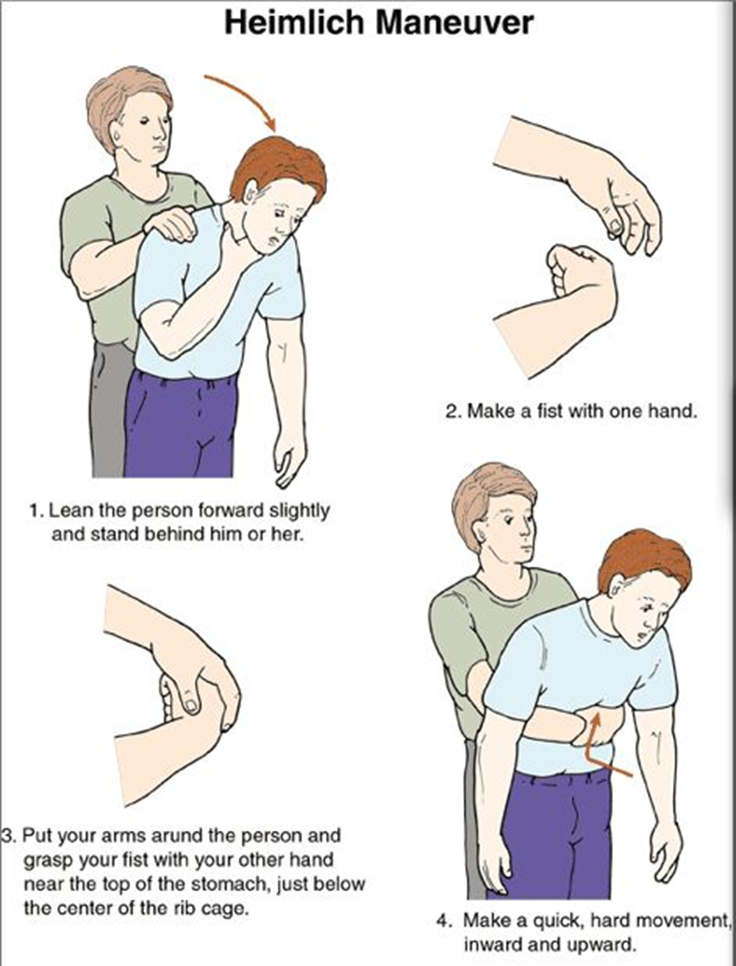A nurse is attending a social event when another guest coughs weakly once, grasps his throat with his hands, and cannot talk. Which of the following actions should the nurse take?
Perform the Heimlich maneuver.
Slap the client on the back several times.
Assist the client to the floor and begin mouth-to-mouth resuscitation.
Observe the client before taking further action.
The Correct Answer is A
Choice A reason:
The Heimlich maneuver, also known as abdominal thrusts, is the recommended first aid technique for a conscious person who is choking. This maneuver helps to expel the object blocking the airway by using the air remaining in the lungs to force it out. The nurse should stand behind the person, place their arms around the person’s waist, make a fist with one hand, and place it just above the navel. The other hand should grasp the fist, and quick, upward thrusts should be performed until the object is expelled.
Choice B reason:
Slapping the client on the back several times is not the recommended first action for a conscious adult who is choking. While back blows can be effective, they are typically used in combination with abdominal thrusts and are more commonly recommended for infants. For adults, the Heimlich maneuver is preferred as the initial response.
Choice C reason:
Assisting the client to the floor and beginning mouth-to-mouth resuscitation is not appropriate for a conscious person who is choking. Mouth-to-mouth resuscitation, or rescue breathing, is used when a person is not breathing and is unresponsive. In this scenario, the client is conscious but unable to speak, indicating a blocked airway that requires the Heimlich maneuver.
Choice D reason:
Observing the client before taking further action is not advisable in a choking emergency. Immediate intervention is crucial to prevent the situation from worsening. If the person is unable to speak, cough, or breathe, the Heimlich maneuver should be performed without delay.

Free Nursing Test Bank
- Free Pharmacology Quiz 1
- Free Medical-Surgical Quiz 2
- Free Fundamentals Quiz 3
- Free Maternal-Newborn Quiz 4
- Free Anatomy and Physiology Quiz 5
- Free Obstetrics and Pediatrics Quiz 6
- Free Fluid and Electrolytes Quiz 7
- Free Community Health Quiz 8
- Free Promoting Health across the Lifespan Quiz 9
- Free Multidimensional Care Quiz 10
View Related questions
Correct Answer is A
Explanation
Choice A: Generalized Urticaria
Generalized urticaria, or widespread hives, is a common sign of an allergic transfusion reaction. This reaction occurs when the recipient’s immune system reacts to proteins in the donor blood. Symptoms can range from mild, such as itching and hives, to severe, including anaphylaxis. Immediate intervention typically involves stopping the transfusion and administering antihistamines.
Choice B: Distended Jugular Veins
Distended jugular veins are not indicative of an allergic transfusion reaction. This finding is more commonly associated with conditions such as congestive heart failure or fluid overload. In the context of a blood transfusion, it could suggest circulatory overload rather than an allergic reaction.
Choice C: Blood Pressure 184/92 mm Hg
An elevated blood pressure reading, such as 184/92 mm Hg, is not specific to an allergic transfusion reaction. While blood pressure changes can occur during a transfusion, they are not a hallmark of an allergic response. This finding could be related to other factors, such as anxiety or pre-existing hypertension.
Choice D: Bilateral Flank Pain
Bilateral flank pain is not a typical symptom of an allergic transfusion reaction. This symptom is more commonly associated with hemolytic transfusion reactions, where the recipient’s immune system attacks the donor red blood cells, leading to hemolysis and subsequent kidney pain.
Correct Answer is B
Explanation
Choice A reason:
Inserting a nasogastric tube is not the first-line intervention for postoperative nausea and vomiting (PONV). This invasive procedure is typically reserved for severe cases where other interventions have failed.
Choice B reason:
Administering an antiemetic is the appropriate action. Antiemetics help control nausea and vomiting, which are common side effects of opioids like morphine. This intervention can provide immediate relief and improve the client’s comfort.
Choice C reason:
Auscultating bowel sounds is important for assessing gastrointestinal function, but it does not directly address the immediate symptom of nausea and vomiting. This assessment can be part of the overall evaluation but is not the primary intervention.
Choice D reason:
Encouraging the client to ambulate is beneficial for overall recovery and can help reduce the risk of complications such as deep vein thrombosis. However, it does not directly address the immediate issue of nausea and vomiting.
